
TNU Journal of Science and Technology
229(06): 302 - 312
http://jst.tnu.edu.vn 302 Email: jst@tnu.edu.vn
COMPARISON STUDY OF PHOTOCATALYTIC DEGRADATION OF
METHYLENE BLUE AND RHODAMINE B WITH ZnO NANORODS
PREPARED BY USING THE HYDROTHERMAL METHOD
Pham Van Tuan1*, Hoang Phi Hung1, Nguyen Ngoc Vu1, Le Tien Ha2,
Tran Thi Quynh Hoa3, Vu Thi Tan4, Tran Ngoc Khiem1
1School of Materials Science and Engineering - Hanoi University of Science and Technology
2TNU - University of Science, 3Hanoi University of Civil Engineering (HUCE)
4 School of Chemistry and Life Sciences - Hanoi University of Science and Technology
ARTICLE INFO
ABSTRACT
Received:
26/4/2024
In this study, ZnO nanorods were fabricated by hydrothermal method at
temperatures of 100, 120, 140 and 160 oC. ZnO nanorods have diameters from
50 nm to 100 nm and lengths up to several µm with the typical hexagonal
structure of ZnO material with (100), (002), (101), (102), (110), (103), (200),
(112), (004), (201), and (202) lattice planes. The positions of the peaks are
almost unchanged with different hydrothermal temperatures. The Raman
scattering analysis shown characteristic vibration modes of ZnO material at 100
cm-1, 200 cm-1, 331 cm-1, 378 cm-1 and 436 cm−1 related to A1, E2 energy levels.
UV-vis results show that the material absorbs strongly in the near ultraviolet
band at 374 nm and gives characteristic emission of ZnO at 401 and 455 nm.
The decomposition process of Methylene blue (MB) and Rhodamine B (RhB)
for ZnO nanorod samples was studied under the visible light. The results shown
that the synthesized ZnO material has the ability to decompose MB up to
94.96% and RhB up to 17.82 % after 120 minutes of illumination.
Revised:
31/5/2024
Published:
31/5/2024
KEYWORDS
ZnO nanorods
Hydrothermal temperature
Photocatalytic activity
Methylene Blue
Decomposition of Rhodamine B
NGHIÊN CỨU SO SÁNH QUÁ TRÌNH PHÂN HỦY QUANG XÚC TÁC
XANH METHYLENE VÀ RHODAMINE B VỚI THANH NANO ZnO
CHẾ TẠO BẰNG PHƯƠNG PHÁP THỦY NHIỆT
Phạm Văn Tuấn1*, Hoàng Phi Hùng1, Nguyễn Ngọc Vũ1, Lê Tiến Hà2,
Trần Thị Quỳnh Hoa3, Vũ Thị Tần4, Trần Ngọc Khiêm1
1Trường Vật liệu - Đại học Bách khoa Hà Nội, 2Trường Đại học Khoa học - ĐH Thái Nguyên
3Trường Đại học Xây dựng, 4 Trường Hóa và Khoa học Sự sống - Đại học Bách khoa Hà Nội
THÔNG TIN BÀI BÁO
TÓM TẮT
Ngày nhận bài:
26/4/2024
Trong nghiên cứu này, thanh nano ZnO được chế tạo bằng phương pháp thủy
nhiệt ở nhiệt độ 100, 120, 140 và 160 oC. Các thanh nano ZnO có đường kính
từ 50 nm đến 100 nm và có chiều dài lên tới vài µm với cấu trúc lục giác đặc
trưng của vật liệu ZnO với các mặt phẳng (100), (002), (101), (102), (110),
(103), (200), (112), (004), (201), và (202). Vị trí của các đỉnh hầu như không
thay đổi ở các nhiệt độ thủy nhiệt khác nhau. Phân tích tán xạ Raman cho
thấy các dạng dao động đặc trưng của vật liệu ZnO ở 100 cm-1, 200 cm-1, 331
cm-1, 378 cm-1 và 436 cm-1 liên quan đến các mức năng lượng A1, E2. Kết quả
UV-vis cho thấy vật liệu hấp thụ mạnh ở vùng tử ngoại gần ở bước sóng 374
nm và cho phát xạ đặc trưng của ZnO ở bước sóng 401 và 455 nm. Quá trình
phân hủy xanh Methylene (MB) và Rhodamine B (RhB) đối với các mẫu
thanh nano ZnO được nghiên cứu dưới ánh sáng khả kiến. Kết quả cho thấy,
vật liệu thanh nano ZnO có khả năng phân hủy MB lên tới 94,96% và RhB
lên tới 17,82% sau 120 phút chiếu sáng.
Ngày hoàn thiện:
31/5/2024
Ngày đăng:
31/5/2024
TỪ KHÓA
Thanh nano ZnO
Phương pháp thủy nhiệt
Quang xúc tác
Xanh Methylene
Phân hủy Rhodamine B
DOI: https://doi.org/10.34238/tnu-jst.10226
* Corresponding author. Email: tuan.phamvan@hust.edu.vn

TNU Journal of Science and Technology
229(06): 302 - 312
http://jst.tnu.edu.vn 303 Email: jst@tnu.edu.vn
1. Introduction
In recent years, the use of various dyes in industries such as textile, leather, paper, and other
fields has increased significantly. However, polluted water from industries containing dyes has
significantly affected biological life and human water sources due to their toxicity and persistent
decomposition. Metal oxide semiconductors such as TiO2, ZnO, and SnO2 are used as effective
photocatalysts for environmental degradation reactions [1] – [4]. Their unique properties such as
high electron mobility, fast charge transfer, tunable band gap, stability, low cost, and
environmental friendliness make them candidates for use as photocatalysts in environmental
applications [2] – [7].
ZnO is the most common n-type semiconductor material, with unique physical and chemical
properties [8] – [12]. Thus, ZnO is a promising material for various applications such as
photocatalysis, solar cells, sensors, and optoelectronics. In the field of photocatalysis, the surface
area of the material is important to increase the adsorption rate of dye molecules, absorbing
incident light for the purpose of decomposing dye molecules [4], [5], [11] – [14]. In
semiconducting metal oxides, ZnO exhibits enhanced photocatalytic activity through the
generation of oxygen vacancies on the surface [4]. Oxygen vacancies serve as active sites for
adsorption of contaminants and facilitate photocatalysis by acting as charge transfer gates
between ZnO nanomaterials and molecules adsorbed [4]. Creating oxygen vacancies on the ZnO
surface can improve the photocatalytic performance of the material considerably, leading to
better environmental remediation results [4]. In addition, the photocatalytic process of ZnO
depends on the properties of the material such as crystallite size, shape as well as synthesizing
conditions of materials [8], [9], [15], [16].
In recent years, several new methods have been developed to control ZnO nanostructures and
morphology [6], [7], [11], [17] – [21]. ZnO with many different morphologies such as nanowires,
nanosheets, nanorods, nanotubes, nanonails, nanospheres, nanoneedles, nanopins, nanoflowers,
nanobelts, and nanopencils are prepared by different methods such as vapor phase, wet
chemistry, and chemical reactions [6], [7], [17] – [21]. Nowadays, photocatalytic performance is
tuned and enhanced by creating desirable physicochemical properties related to size, and
morphology [5], [14], [15]. Targeting the degradation of environmental pollutants depends on the
specific crystal face expression of nanomaterials. Therefore, crystalline surface engineering is a
very importance strategy. However, controlling the aspect of ZnO photocatalysts remains a
challenge, from which their photocatalytic activity and industrial applications are limited.
In this study, we report on the hydrothermal synthesis of ZnO nanorods and the change in
photocatalytic properties with different hydrothermal temperatures in the decomposition of
Methylene blue (MB) and Rhodamine B (RhB) under visible light. Firstly, the influence of
hydrothermal temperature on the crystal structure, material morphology, and optical properties of
the material is studied. Then, the photocatalytic properties of ZnO nanorods in the degradation of
MB and RhB were compared. Furthermore, the relationship between the structural, morphology,
optical, and photocatalytic properties of ZnO nanorods was discussed.
2. Experiment
2.1. Materials
Zinc acetate dihydrate (Zn(CH3COO)2.2H2O), potassium hydroxide (KOH), methanol
(CH3OH), and MB (C16H18ClN3S) were purchased from Sigma-Aldrich. All other chemicals were
of analytical grade and used as received without purification.
2.2. Synthesis of ZnO nanorods
First, 10 g of Zn(CH3COO)2.2H2O in 70 ml of methanol were dissolved with a magnetic
stirrer at room temperature for 30 minutes to obtain solution A. Next, 5 g of KOH were dissolved

TNU Journal of Science and Technology
229(06): 302 - 312
http://jst.tnu.edu.vn 304 Email: jst@tnu.edu.vn
in 50 ml of methanol with a magnetic stirrer at room temperature for 30 minutes to obtain
solution B. Solution B was then dropped slowly into solution A, and the mixture was stirred
slowly at room temperature for 30 minutes. Then, this solution mixture was placed in a water
bath at a temperature of 100 °C, and stirring was continued for 25 minutes to form a
homogeneous solution. The resulting mixture was poured into a Teflon autoclave and
hydrothermally heated at a temperature of 100 ℃ for 24 h. After the hydrothermal process, the
hydrothermal autoclave was naturally cooled to room temperature. The resulting precipitate was
filtered and washed with a centrifuge at a speed of 4000 rpm and every 5 minutes with distilled
water and methanol to remove excess ions remaining in the sample. Finally, the precipitate was
dried at 80 ℃ for 24 h. The final product obtained is white ZnO powder. ZnO samples with
hydrothermal temperatures of 120 °C, 140 °C, and 160 °C were fabricated through a similar
process. These samples are named ZnO-100 °C, ZnO-120 °C, ZnO-140 °C, and ZnO-160 °C
corresponding to hydrothermal temperatures of 100 °C, 120 °C, 140 °C, and 160 °C.
2.3. Characterization techniques
An X-ray diffractometer with Cu-Kα radiation at wavelength λ = 1.5406 Å was used to study
the crystal structure and size of the ZnO material. A UV-visible spectrophotometer (V-650 Jasco,
USA) was used to measure the UV-vis absorption spectra of the ZnO material. A field emission
scanning electron microscope (FESEM; Hitachi S-4800) was used to study the surface
morphology and size of the ZnO nanorods. The photoluminescence properties of materials used
studied by photoluminescence spectroscopy at an excitation wavelength of 370 nm using a 250
W Xe lamp and the structural properties and vibration modes of ZnO samples was investigated
by Raman scattering spectra.
2.4. Photocatalytic degradation experiments
MB and RhB dyes were used as contaminants to evaluate the photocatalytic performance of
ZnO nanorod samples. In this experiment, 0.01 g of catalyst was dissolved into 100 mL of dye
solution in a photocatalytic reactor to decompose MB and RhB. The catalyst and dye solution
were stirred magnetically for 30 minutes in the dark. Then, the solution mixture was illuminated
with visible light. Every 20 minutes of illumination, 5 mL of the mixture were taken out and
centrifuged to remove the catalyst and measure the absorption spectra of the remaining solution
to investigate the photocatalytic decomposition of the dye. The photocatalytic degradation
efficiency of ZnO nanorod material is determined in % using the following formula [21]–[23]:
0
0
% 100
t
CC
DC
(1)
where C0 and Ct are the absorbance of the dye before illumination and at different illumination
durations, respectively.
3. Results and Discussion
X-ray diffraction pattern is used to determine the crystal phase, structure, and purity of ZnO
nanomaterials. Figure 1 shows the X-ray diffraction patterns of ZnO nanorods with different
hydrothermal temperatures. The results show that the diffraction peaks are intense and sharp,
indicating a high degree of crystallinity of the ZnO nanomaterial. The diffraction peak positions
of the ZnO samples were observed at 31.62°, 34.27°, 36.06°, 47.35°, 56.32°, 62.65°, 66.16°,
67.77°, 68.88°, 72.31°, and 76.84°, corresponding to the (100), (002), (101), (102), (110), (103),
(200), (112), (004), (201), and (202) crystal planes of ZnO [20], [21], [23], [24]. The positions of
these diffraction peaks are consistent with the JCPDS standard card (PDF card no. 04-003-2106)
for the hexagonal structure of the ZnO crystal lattice [21]. When the hydrothermal temperature is
changed, the position of the diffraction peaks does not change. This finding proves that

TNU Journal of Science and Technology
229(06): 302 - 312
http://jst.tnu.edu.vn 305 Email: jst@tnu.edu.vn
hydrothermal temperature does not affect the diffraction peak position of ZnO. However, with
different hydrothermal temperatures of 100 °C, 120 °C, and 160 °C, the diffraction peak (101) has
greater intensity than the diffraction peak (100). This condition proves that ZnO nanorods grow
mainly in the (101) direction. However, when ZnO nanorods are fabricated with a hydrothermal
temperature of 140 °C, the (100) diffraction peak surprisingly has a greater intensity than the (101)
diffraction peak, thus demonstrating that the ZnO nanorods grow mainly in the (100) direction. The
(100) peak has a higher intensity than the (101) peak, which is explained by the fact that 140 °C is
the appropriate temperature to grow ZnO nanocrystals in the (100) direction compared to the (101)
direction. This result is interesting, indicating that changing the hydrothermal temperature enables
the growth direction of ZnO nanorods to be controlled.
Figure 1. X-ray diffraction patterns of ZnO nanorods at different hydrothermal temperatures
From the results of X-ray diffraction measurements, we can determine the crystallite size of
ZnO nanorods using the Debye–Scherrer expression [24]–[26].
( )⁄ (2)
where D is the average crystallite size, λ is the wavelength of the X-ray (1.5406 Å), θ is half
the Bragg diffraction angle, and β stands for FWHM. In addition, the interplane distance (d),
lattice constants a and c of ZnO are determined by formulas (3) and (4) [27], [28].
2 n d sin
(3)
2 2 2
2 2 2
14
()
3
h hk k l
d a c
(4)
where h, k, and l are Miller indices; a and c are lattice constants; and d is the interplane distance.
The average crystal size, the interplane distance, and lattice constants are presented in Table 1.
Figure 2 presents FESEM images of ZnO samples fabricated at different hydrothermal
temperatures: (A1−A2) 100 °C, (B1−B2) 120 °C, (C1−C2) 140 °C, and (D1−D2) 160 °C. The results
show that the ZnO nanorods formed in Figures A1–A2 grow uniformly. Individual nanorods are
about 100 nm to 200 nm wide and about 1 μm to 2 μm long. Evidently, the ZnO nanorods exhibit
a distinct hexagonal structure. When the hydrothermal temperature increases to 120 °C in Figures
B1–B2, the width of the ZnO nanorods is about 50 nm to 70 nm, and the length of the ZnO
nanorods is about 2 μm to 3 μm. Compared with the hydrothermal sample at 100 °C, the width of
the ZnO nanorods decreased significantly and the length of the ZnO nanorods increased. This
condition can be explained by the fact that at high hydrothermal temperature and pressure, ZnO
crystal seeds grow faster, causing the width of the ZnO nanorod to decrease and the length of the
ZnO nanorod to increase. When the hydrothermal temperature continues to increase to 140 °C
(Figures C1–C2) and 160 °C (Figures D1–D2), the width of the ZnO nanorod and the length of the
ZnO nanorod are similar to those of the hydrothermal sample at 120 °C. From this observation,
we can control the width and length of ZnO nanorods by using the hydrothermal temperature.
This result is interesting for the study of photocatalytic properties. In comparison with the crystal
20 30 40 50 60 70 80
(202)
(201)
(004)(112)
(200)
(103)
(102)
(110)
(101)
(002)
(100)
160 °C
140 °C
120 °C
100 °C
Intensity (a.u.)
2θ (°)

TNU Journal of Science and Technology
229(06): 302 - 312
http://jst.tnu.edu.vn 306 Email: jst@tnu.edu.vn
size results calculated from XRD shows that the crystallite sizes calculated from XRD are
generally smaller than those observed from FESEM images. This result is explained as follows:
Crystallite crystal size is calculated from XRD. These are homogeneous crystalline regions
(coherent scattering regions). The ideal crystal is an infinite homogeneous region where XRD
only obtains peaks that are lines. But in reality, the region where the crystals are periodically
arranged uniformly is only small, so the XRD peak is broadened. The smaller the homogeneous
area, the wider the peak. When observing nanorods from FESEM images, these nanorods contain
several different uniform crystalline regions, so the crystallite size is smaller than the size
observed from FESEM. If the nanoparticles are small, each nanoparticle is a uniform region, then
the crystallite size is equal to the particle size.
Table 1. Average crystallite size, lattice constants, and d-spacing of ZnO nanorods at different
hydrothermal temperatures
Sample
Position
(2θ)
(hkl)
FWHM
Crystallite size
(D) (nm)
Average crystallite
size (nm)
d-spacing
(nm)
Lattice parameters
a = b (nm)
c (nm)
ZnO-
100 °C
31.75
(100)
0.09
95.89
97.28
0.26
0.30
0.52
34.40
(002)
0.08
108.62
36.24
(101)
0.10
87.34
ZnO-
120 °C
31.74
(100)
0.20
43.15
54.58
0.26
0.30
0.52
34.40
(002)
0.11
78.99
36.23
(101)
0.21
41.59
ZnO-
140 °C
31.75
(100)
0.15
57.53
66.34
0.26
0.30
0.52
34.40
(002)
0.10
86.89
36.23
(101)
0.16
54.59
ZnO-
160 °C
31.75
(100)
0.17
50.76
66.23
0.26
0.30
0.52
34.40
(002)
0.09
96.55
36.24
(101)
0.17
51.38
Figure 2. FESEM images of ZnO nanorods at different hydrothermal temperatures


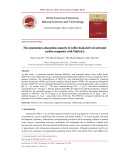
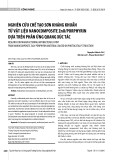
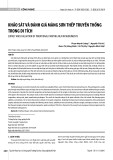
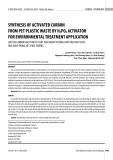
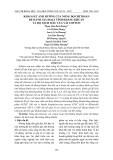

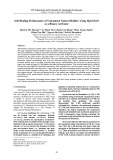
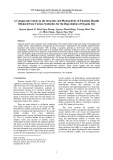


![Tài liệu Vi sinh vật môi trường [Mới nhất]](https://cdn.tailieu.vn/images/document/thumbnail/2025/20251123/ngkimxuyen/135x160/21891763953413.jpg)
![Sổ tay truyền thông Phân loại chất thải rắn sinh hoạt trên địa bàn tỉnh Quảng Nam [Chuẩn nhất]](https://cdn.tailieu.vn/images/document/thumbnail/2025/20251114/kimphuong1001/135x160/1701763094001.jpg)


![Quản lý chất thải nguy hại: Sổ tay Môi trường [Chuẩn nhất]](https://cdn.tailieu.vn/images/document/thumbnail/2025/20251029/kimphuong1001/135x160/9011761720170.jpg)









